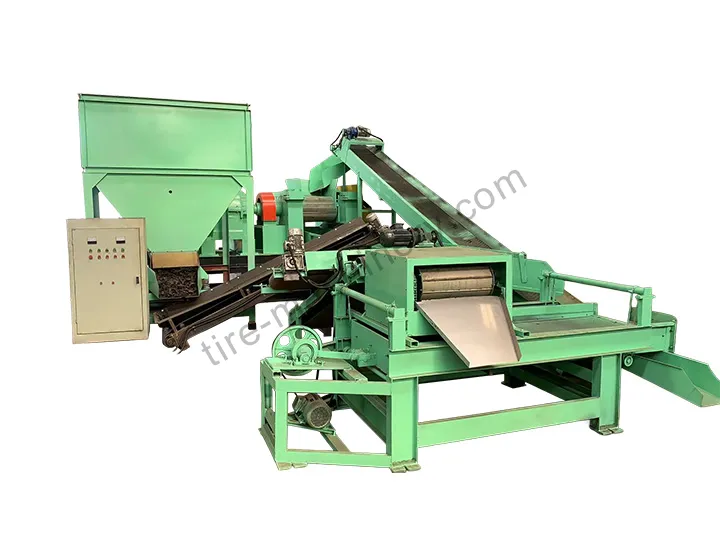The Ultimate Buyer’s Guide: 7 Features to Check When You Buy a Tire Grinding Machine
This buyer’s guide provides a 7-point checklist for anyone looking to buy a tire grinding machine. It moves beyond price to focus on critical long-term value factors. The guide details what to look for in roller material and design, energy efficiency (bearing structure), drive system stability (gearbox), capacity, safety features, and manufacturer warranty, empowering buyers to make a smart investment.

To buy a tire grinding machine is a major capital investment that will form the core of your recycling operation for years to come. While price is an important factor, the true value of a machine lies in its performance, durability, and long-term operational cost. Making the right choice means knowing exactly what to look for beyond the surface specifications.
This guide is designed to empower you with the knowledge to evaluate and compare different options like an expert. Here are the seven critical features that separate a high-performance machine from a costly liability.
1. Roller Material and Design: The Heart of the Grinder
The rollers perform the most demanding task in the entire process. Their durability directly impacts your uptime and maintenance costs.
- What to Look For: Ask about the specific tire grinder roller material. Avoid standard cast iron, which is brittle and prone to cracking. Look for high-strength, wear-resistant alloys. A design with grooves on both rollers provides superior grinding force and efficiency compared to a single-groove design.
- Why It Matters: Superior alloy rollers, like those made from 5Cr6MnMo, can last for years with only occasional re-welding, saving you thousands in replacement costs and downtime.
2. Energy Efficiency: The Hidden Cost Center
A grinder’s electricity consumption is its single largest running cost. An inefficient machine can wipe out your profit margins.
- What to Look For: Ask about the tire grinder bearing design. The key to an energy efficient tire grinder is minimizing friction. Look for designs that use advanced rolling bearings (like double-row systems) instead of older, high-friction alternatives.
- Why It Matters: A well-engineered, low-friction design can use up to 40% less electricity, which translates into tens of thousands of dollars in savings annually for a typical operation.
3. Drive System Stability: The Gearbox
The gearbox translates motor power into the immense torque needed to grind rubber. A weak or poorly designed gearbox is a primary point of failure.
- What to Look For: Inquire about the type of tire grinder gearbox used. Look for robust designs like hyperbolic gear reducers with double-row gears, which offer a higher load capacity and longer service life than simpler, single-row gear systems.
- Why It Matters: A superior gearbox ensures smooth, reliable power delivery under constant heavy load, preventing costly breakdowns and ensuring consistent performance.
4. Real-World Capacity and Output Adjustability
A tyre grinder machine’s stated capacity should be realistic and adaptable to your needs.
- What to Look For: Ask how the rubber powder machine capacity changes with different output mesh sizes. A good machine should have easily interchangeable screens, allowing you to produce both coarse granules and fine powder to meet different market demands.
- Why It Matters: Versatility is key. The ability to adjust your output allows you to pivot to more profitable products as market conditions change.
5. Safety Features
The safe operation of industrial machinery is non-negotiable.
- What to Look For: Check for standard industrial grinder safety features like accessible emergency stop buttons, protective guards over moving parts, and clear operational safety instructions.
- Why It Matters: A tire grinder built with safety in mind protects your most valuable asset: your employees.
6. Manufacturer Support and Warranty
Your relationship with the supplier doesn’t end after the sale.
- What to Look For: Choose a tire grinder machine manufacturer, not just a reseller. A direct manufacturer will have deeper technical knowledge, better spare parts availability, and a vested interest in your success. Ask specifically about the tire recycling machine warranty, especially for critical components like the rollers.
- Why It Matters: A strong warranty (e.g., a 3-year warranty on rollers) is a clear sign of the manufacturer’s confidence in their product’s quality and durability.
Rubber Tire Crusher Machine
7. System Integration Capability
A tyre grinder is rarely a standalone machine. It must work as part of a larger system.
- What to Look For: A reliable supplier should be able to provide not just the grinder, but a complete, integrated system, from a basic complete rubber powder production line to a heavy-duty specialized OTR tire recycling line.
- Why It Matters: When you buy a tire grinding machine from a supplier who understands the entire process, you ensure seamless integration and optimized performance across your entire operation.
Your Purchasing Checklist
By using this guide, you are now equipped to make an informed, intelligent investment.
Ready to see how our equipment stacks up against this checklist? Contact our technical experts today and put our machines to the test.

